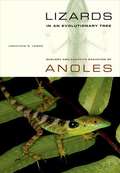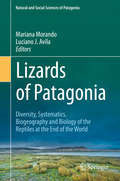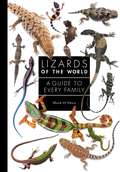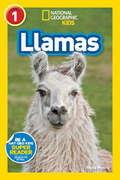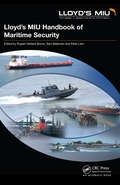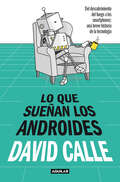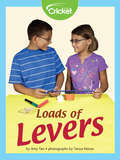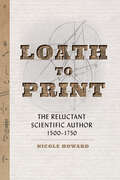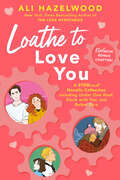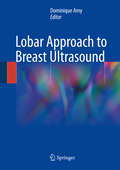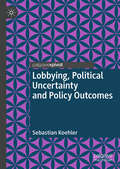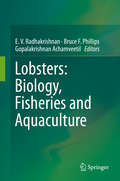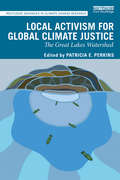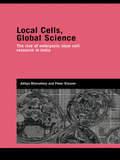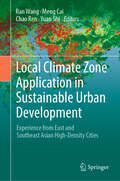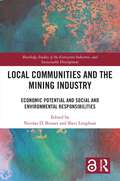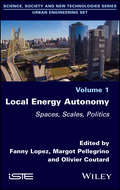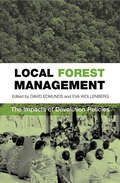- Table View
- List View
Lizards in an Evolutionary Tree: Ecology of Adaptive Radiation in Anoles
by Jonathan B. LosesAdaptive radiation, which results when a single ancestral species gives rise to many descendants, each adapted to a different part of the environment, is possibly the single most important source of biological diversity in the living world. One of the best-studied examples involves Caribbean Anolis lizards. With about 400 species, Anolis has played an important role in the development of ecological theory and has become a model system exemplifying the integration of ecological, evolutionary, and behavioral studies to understand evolutionary diversification. This major work, written by one of the best-known investigators of Anolis,reviews and synthesizes an immense literature. Jonathan B. Losos illustrates how different scientific approaches to the questions of adaptation and diversification can be integrated and examines evolutionary and ecological questions of interest to a broad range of biologists.
Lizards of Patagonia: Diversity, Systematics, Biogeography and Biology of the Reptiles at the End of the World (Natural and Social Sciences of Patagonia)
by Mariana Morando Luciano J. AvilaThis book presents a critical and integrated review of lizards from Patagonia. It summarizes the region’s geomorphological history and climatic aspects, which makes it possible to interpret, from an evolutionary perspective, the latest findings on the various natural history aspects of its lizard fauna. As such, the book will appeal to all researchers and professionals specialized in lizard ecology and evolution.
Lizards of the World: A Guide to Every Family
by Mark O'SheaA lavishly illustrated overview of the world’s lizardsLizards are one of nature’s great success stories: survivors from the time of the dinosaurs, they have taken advantage of almost every habitat on earth, from tropical rainforest to Arctic tundra and even our homes. From chameleons and skinks to geckos and iguanas, there are close to 7,000 species of lizards around the world. This expert guide explores their extraordinary diversity and adaptations.Lizards of the World features an in-depth introduction covering the evolution, anatomy, and lifestyle of lizards, followed by profiles of species from every family, accompanied by stunning color photographs. This invaluable guide highlights the enormous range of habitats, appearance, and activity among lizards. Many thrive in extreme conditions, and have adapted to keep cool, warm, or hydrated. Some can protect themselves by changing color to blend in with their surroundings, while others have fringed toes enabling them to run across sand, or can parachute out of a predator’s reach. Covering diet and reproduction as well as defense strategies and conservation, Lizards of the World showcases the unique natural history and beauty of these remarkable creatures.More than 200 detailed photographic images80+ lizard families and subfamiliesExploration of lizard biology, behavior, habits, and distributionBroad coverage and in-depth treatment by a world-renowned herpetologist
Lizards of the World: Natural History and Taxon Accounts
by Gordon H. RoddaOur planet is literally crawling with lizards. More than 6500 species are known to science, and new species are being discovered annually. In this monumental work, eminent researcher Gordon Rodda has created the first compilation of the natural histories of all the world's lizards and amphisbaenians, as well as the Tuatara. Although other books have attempted to survey the scope of adaptations present in the world's lizards, only Rodda has been able to quantify and summarize all species or higher taxa. Analyzing the relationships among traits such as morphologic characteristics, reproductive strategies, and food sources, Rodda uncovers novel insights into reptile ecology. Identifying 14 recurring character syndromes across all the world's lizards, he proposes a new lens for categorization. He also touches on • common names• geographic range• length• mass• age• maturation• differences between the sexes• nominal variables, including diel activity cycle and foraging mode• home range• predator avoidance tactics• thermal biology• social spacing• climate envelope• habitat and microhabitat• reproduction• parental care• diet• population density• conservation status• ecological business modelsRodda's alphabetical taxon accounts provide an instantly retrievable sketch of every species, genus, and family. Outlining more than 1500 statistically significant associations extracted from a data matrix composed of more than 300 conditions tabulated—to the extent known—for all 6528 species of lizards, Lizards of the World will be the go-to source for the next generation of reptile ecologists, as well as herpetology students and serious herpetoculturists.
Lizzo: Award-Winning Musician (Movers, Shakers, and History Makers)
by Karen Latchana KenneyIn September 2019, “Truth Hurts” became the longest-reigning solo female rap song at the number 1 spot on Billboard’s Hot 100. Since then, Lizzo has appeared on TV, at award shows, and on sold-out world tours. Learn more about this Grammy-winning artist and how she went from band kid to opening act to mainstream superstar.
Llamas (Readers)
by Maya MyersLearn all about the fascinating lives of llamas--including what they eat, where they live, how they help people, and their behavior in this new National Geographic Kids Reader. The level 1 text provides accessible, yet wide-ranging, information for beginning readers.National Geographic Kids Readers have been a hit in the beginning reader category, and this book builds on that success with the same combination of careful text, brilliant photographs, and fun approach to high-interest topics, such as llamas, that has proved to be a winning formula with kids.
Lloyd's MIU Handbook of Maritime Security
by Peter Lehr Sam Bateman Rupert Herbert-BurnsManaging the ever-changing nature and cross-disciplinary challenges of the maritime sector demands a complete understanding of the special characteristics of the maritime space. The complexity of the operations of ships, ports, shipping companies, and naval and coast guard maritime security operations as well as the economic significance and the in
Lo que sueñan los androides: Del descubrimiento del fuego a los Smartphones: una breve historia de la tecnología
by David CalleDel descubrimiento del fuego a los smartphones: una breve historia de la tecnología.Del profesor estrella de YouTube finalista del Global Teacher Prize y una de las personas más creativas del mundo según Forbes. Cuando nos adentramos en la sección de tecnología de un centro comercial, encontramos ordenadores portátiles ultraligeros, cables USB, smartphones de última generación, smartwatches, pulseras biométricas y hasta cámaras especiales para youtubers. Solemos asociar la tecnología a los últimos gadgets electrónicos que, para bien o para mal, han colonizado nuestro día a día. Uno de los mayores horrores de la vida contemporánea es quedarse sin batería o sin conexión, como si nos perdiéramos en una dimensión desconocida de la realidad, lejos del mundo y de nuestros congéneres. Pero la tecnología es una cosa mucho más amplia. Y mucho más antigua.Un día muy lejano, hace decenas de miles de años, un homínido cualquiera chocó una piedra contra otra y creó un cuchillo de sílex. Con aquel primate comienza este viaje: el de la historia de la tecnología en los albores de nuestra especie. Y sin necesidad de wifi ni de un enchufe. Desde entonces, la humanidad ha recorrido un apasionante camino, desde la invención del plástico hasta la exploración espacial, que juntos vamos a conocer a través de los descubrimientos tecnológicos que modificaron el rumbo de la historia.David Calle es licenciado en ingeniería de sistemas de telecomunicación. Tiene un canal de YouTube, Unicoos, donde enseña matemáticas y ciencias, que se ha convertido en uno de los canales educativos más importantes del mundo con casi un millón y medio de suscriptores. Según la revista Forbes, es una de las cien personas más creativas del mundo. En 2015, su canal fue elegido por Google como el de mayor impacto social y en 2017, David Calle quedó entre los 10 finalistas del Global Teacher Prize. La crítica ha dicho:«Raro es el estudiante de primero o segundo de una carrera técnica que no conozca a David Calle».El País«Este ingeniero ha conseguido colarse en la élite de la docencia».El confidencial«Hay un profesor youtuber que será la salvación de tu hijo si este tiene problemas con las ciencias».Cadena Dial
Lo!
by Charles FortLo! was Charles Fort's third book. In it Fort examines a multitude of scientific anomalies. Fort is widely credited to have coined the now-popular term teleportation in this book, and here he ties his previous statements on what he referred to as the Super-Sargasso Sea into his beliefs on teleportation. He would later expand this theory to include purported mental and psychic phenomena in his fourth and final book, Wild Talents.
Load-Pull Techniques with Applications to Power Amplifier Design
by Fadhel M. Ghannouchi Mohammad S. HashmiThis first book on load-pull systems is intended for readers with a broad knowledge of high frequency transistor device characterization, nonlinear and linear microwave measurements, RF power amplifiers and transmitters. Load-Pull Techniques with Applications to Power Amplifier Design fulfills the demands of users, designers, and researchers both from industry and academia who have felt the need of a book on this topic. It presents a comprehensive reference spanning different load-pull measurement systems, waveform measurement and engineering systems, and associated calibration procedures for accurate large signal characterization. Besides, this book also provides in-depth practical considerations required in the realization and usage of load-pull and waveform engineering systems. In addition, it also provides procedure to design application specific load-pull setup and includes several case studies where the user can customize architecture of load-pull setups to meet any specific measurement requirements. Furthermore, the materials covered in this book can be part of a full semester graduate course on microwave device characterization and power amplifier design.
Loads of Levers
by Amy TaoWhy does a baseball travel much faster when hit with a bat than if pitched? Learn how force is applied in this fun experiment! Using a marker, a ruler, and a can, you can perform your own lever experiments. You'll understand the power of weight, such as how a balance beam operates, but on a smaller scale, while learning about the science behind balance.
Loath to Print: The Reluctant Scientific Author, 1500–1750
by Nicole HowardWhy did so many early modern scientific authors dislike and distrust the printing press?While there is no denying the importance of the printing press to the scientific and medical advances of the early modern era, a closer look at authorial attitudes toward this technology refutes simplistic interpretations of how print was viewed at the time. Rather than embracing the press, scientific authors often disliked and distrusted it. In many cases, they sought to avoid putting their work into print altogether. In Loath to Print, Nicole Howard takes a fresh look at early modern printing technology from the perspective of the natural philosophers and physicians who relied on it to share ideas. She offers a new perspective on scientific publishing in the early modern period, one that turns the celebration of print on its head. Exploring both these scholars' attitudes and their strategies for navigating the publishing world, Howard argues that scientists had many concerns, including the potential for errors to be introduced into their works by printers, the prospect of having their work pirated, and most worrisome, the likelihood that their works would be misunderstood by an audience ill-prepared to negotiate the complexities of the ideas, particularly those that were mathematical or philosophical. Revealing how these concerns led authors in the sciences to develop strategies for controlling, circumventing, or altogether avoiding the broad readership that print afforded, Loath to Print explains how quickly a gap opened between those with scientific knowledge and a lay public—and how such a gap persists today. Scholars of the early modern period and the history of the book, as well as those interested in communication and technology studies, will find this an accessible and engaging look at the complexities of sharing scientific ideas in this rich period.
Loathe to Love You
by Ali HazelwoodFrom the New York Times bestselling author of The Love Hypothesis comes a collection of steamy, STEMinist novellas featuring a trio of engineers and their loves in loathing—with a special bonus chapter! <p><p>Under One Roof <p>An environmental engineer discovers that scientists should never cohabitate when she finds herself stuck with the roommate from hell—a detestable big-oil lawyer who won’t leave the thermostat alone. <p><p>Stuck with You <p>A civil engineer and her nemesis take their rivalry—and love—to the next level when they get stuck in a New York elevator. <p><p>Below Zero <p>A NASA aerospace engineer's frozen heart melts as she lies injured and stranded at a remote Arctic research station and the only person willing to undertake the dangerous rescue mission is her longtime rival. <p> <b>New York Times Bestseller</b>
Lobar Approach to Breast Ultrasound
by Dominique AmyThis book focuses on the lobar anatomy of the breast and on the sick lobe concept – a novel theory of breast cancer development that is gaining ever wider acceptance – and explores their significance for innovative surgical treatment. Special attention is paid to the role of ductal echography, a technique capable of clearly depicting the structures of cancer in relation to the structures of the sick lobe. Having established a sound theoretical and practical basis through detailed coverage and correlation of anatomy, pathology, and imaging appearances, the book goes on to describe a revolutionary surgical approach particularly suitable for the treatment of multifocal and multicentric breast carcinomas. Such tumors account for more than a third of all cases of breast carcinoma and are often treated by mastectomy. The proposed new breast-conserving technique yields excellent cosmetic results and entails a very low risk of recurrence. The book will appeal to a wide readership, including radiologists, surgeons, oncologists, pathologists, as well as residents.
Lobbying, Political Uncertainty and Policy Outcomes
by Sebastian KoehlerThis book analyses interest group communication strategies in parliamentary political systems, and considers how political uncertainty, which emerges from the political process, shapes interest group communication strategies. It develops a formal model of lobbying in a bicameral legislature with strong party discipline, and discusses why interest groups choose public or private communication channels to influence political bargaining. The book tests its hypothesis in different policy contexts, including lobbying on major legislation in the field of labour and social policy.
Lobsters: Biology, Fisheries and Aquaculture
by Bruce F. Phillips E. V. Radhakrishnan Gopalakrishnan AchamveetilThis book is an important addition to the knowledge of lobster research. The book complements other books published on lobster research and management as it focuses on Indian lobster fisheries and aquaculture developments where there have been nearly 350 research papers and reports and 19 PhD awards. The book has 15 chapters written by international experts covering many aspects of the biology of a number of spiny and slipper lobster species occurring in India and world oceans with maps illustrating global distribution of spiny lobster families, genera and species. An updated taxonomy and checklist of marine lobsters, the status and management of lobster fisheries in India and Indian Ocean Rim countries and a review of aquaculture research in India and other major countries have also been presented. The book is timely as the 2nd International Indian Ocean Expedition (IIOE) is currently underway (2015-2020), 50 years after the original IIOE (1959-1965), with some of the original lobster research on the biology and distribution of phyllosoma larvae being undertaken on the plankton samples collected during the first IIOE. Many of the chapters are contributed by the authors from Central Marine Fisheries Research Institute (CMFRI), which has been collecting fishery and biological data on lobsters since 1950 when lobster fishing began on a subsistence scale, followed by some industrial fishing for lobsters in different parts of India. Unfortunately, the development of some of these lobster fisheries was followed by overfishing due to lack of enforcement of regulations. The book provides a valuable addition to our knowledge of the biology, fisheries and aquaculture of spiny and slipper lobsters.
Local Activism for Global Climate Justice: The Great Lakes Watershed (Routledge Advances in Climate Change Research)
by Patricia E. PerkinsThis book will inspire and spark grassroots action to address the inequitable impacts of climate change, by showing how this can be tackled and the many benefits of doing so. With contributions from climate activists and engaged young authors, this volume explores the many ways in which people are proactively working to advance climate justice. The book pays special attention to Canada and the Great Lakes watershed, showing how the effects of climate change span local, regional, and global scales through the impact of extreme weather events such as floods and droughts, with related economic and social effects that cross political jurisdictions. Examining examples of local-level activism that include organizing for climate-resilient and equitable communities, the dynamic leadership of Indigenous peoples (especially women) for water and land protection, and diaspora networking, Local Activism for Global Climate Justice also provides theoretical perspectives on how individual action relates to broader social and political processes. Showcasing a diverse range of inspirational and thought-provoking case studies, this book will be of great interest to students and scholars of climate justice, climate change policy, climate ethics, and global environmental governance, as well as teachers and climate activists.
Local Cells, Global Science: The Rise of Embryonic Stem Cell Research in India (Genetics and Society)
by Aditya Bharadwaj Peter GlasnerOne of the first studies of an exciting new development in global biotechnology, this cutting edge text examines the extent of the transnational movements of tissues, stem cells, and expertise, in the developing governance framework of India. Documenting the impact of local and global governance frames on the everyday conduct of research, this groundbreaking book traces the journey of ‘spare’ human embryos in IVF clinics to public and private laboratories engaged in isolating stem cells for potential therapeutic application. The discussion also examines the gender dimension as a potential site for exploitation in the sourcing of embryonic and other biogenic materials, and suggests that a moral economy has developed in which the ethical values of the global 'North' support and encourage the donation of abundant and ethically ‘neutral’ embryos by the 'South'. This unique exploration is grounded in an empirical, multi-sited ethnographic study that takes a thoroughly comparative analysis of the ethical, religious and social issues in Europe, the United States, and organ donations already prevalent in India. In this theoretically-sensitive analysis, the authors use the resources of social anthropology and the social sciences in an innovative text which will appeal to postgraduates and professionals in the areas of STS studies, genetics, bioethics, and anthropology.
Local Climate Zone Application in Sustainable Urban Development: Experience from East and Southeast Asian High-Density Cities
by Ran Wang Chao Ren Meng Cai Yuan ShiThe study of local climate zones (LCZ) links urban morphology, land use and land cover types, human activity, and thermal properties, and provides a standard framework for studying urban climatic issues. In recent years, the LCZ scheme attracts more and more attention from climatologists, urban planners, environmental engineers, as well as architects due to its combination of urban climatic scientific research outputs and urban planning and morphology language. Urbanization and higher-density living, an ongoing and continued path of human development, brings various urban climatic and environmental problems. Urban development in a sustainable way is vital for high-density cities to build a comfortable living environment.This book is the first one presenting systematically the latest LCZ applications by taking Asian high-density cities as an example. Generally, four parts are introduced and discussed in this book. At first, a general background of urbanization and its impacts is introduced, and the basic knowledge of LCZ. The second part introduces the methodology and techniques of LCZ data development. In the third part, various applications of LCZ are demonstrated in practice, including application to urban heat island, land use and land cover analysis, wind environment, energy consumption, thermal comfort studies and so on. Lastly, this book concludes the progress, challenges, limitations, and future work of LCZ-related studies.The book will be of interest to all that are working on or interested in urban climate, sustainable urban development, and policy-making.
Local Communities and the Mining Industry: Economic Potential and Social and Environmental Responsibilities (Routledge Studies of the Extractive Industries and Sustainable Development)
by Nicolas D. Brunet Sheri LongboatThis book explores the challenges and opportunities at the intersection of the global mining sector and local communities by focusing on a number of international cases drawn from various locations in Canada, the Philippines, and Scandinavia. Mining’s contribution to economic development varies greatly across countries. In some, it has been a major engine of development, but in others, disputes have erupted over land use, property rights, environmental damage, and revenue sharing. Corporate social responsibility programs are increasingly relied upon to manage company-community relations, yet conflicts persist in many settings, with significant costs for companies and communities. Exploring the many factors and drivers that characterize relationships among different actors within the sector, the volume contributes towards the development of practical wisdom, collective understanding, common sense, and prudence required for the mining sector and community partners to realize the economic potential and social and environmental responsibilities of non-renewable resource development. The book examines case studies from Canada, Scandinavia, and the Philippines, three regions amongst the world's top countries of mining operations. Drawing on their extensive experience in these regions, the contributors explore distinctive mining sectors in the Global North and South, the variation surrounding different types of extractive industries, and at different scales, and the legal processes in place to protect local communities. Key themes include corporate social responsibility, impact assessment, foreign ownership, Indigenous Peoples, gender, local insurgency, and mining disasters as well as climate change. The book identifies areas of future research and pathways to achieving stronger, respectful, and mutually beneficial relationships at the nexus of global mineral extraction and local communities. This book will be of great interest to students and scholars of the extractive industries, natural resource management, sustainable business and corporate social responsibility, Indigenous studies, and sustainable planning and development.
Local Economic Development and the Environment
by David GibbsThis book focuses upon the potential to integrate economic and environmental policies at the local and regional scale. Local initiatives are investigated within their wider economic and environmental policy contexts in order to illustrate both the constraints and opportunities for local policy makers. Attention is given to global economic trends, as well as to the specific policy contexts of the European Union and the national contexts of the UK, USA, Australia, Japan and Sweden. The key principles for designing integrative policies and descriptions of initiatives and projects in a variety of locations are also considered.
Local Electrode Atom Probe Tomography
by David J. Larson Ty J. Prosa Robert M. Ulfig Brian P. Geiser Thomas F. KellyThis book is the first, single-source guide to successful experiments using the local electrode atom probe (LEAP®) microscope. Coverage is both comprehensive and user friendly, including the fundamentals of preparing specimens for the microscope from a variety of materials, the details of the instrumentation used in data collection, the parameters under which optimal data are collected, the current methods of data reconstruction, and selected methods of data analysis. Tricks of the trade are described that are often learned only through trial and error, allowing users to succeed much more quickly in the challenging areas of specimen preparation and data collection. A closing chapter on applications presents selected, state-of-the-art results using the LEAP microscope.
Local Energy Autonomy: Spaces, Scales, Politics
by Olivier Coutard Fanny Lopez Margot PellegrinoIn Europe, numerous forms of energy self-sufficiency or small technical systems exist, are promoted and discussed. They share the ambition to reduce the dependence to inherited/incumbent large technical systems in various sectors (energy and water supply, sanitation, waste management...) through the implementation of “local” energy systems and “small” grids. The contemporary energy and environmental crisis could rush the end of large technical systems (networks and infrastructures) as they have been developed since the late 19th century. This book examines the various options to transition.
Local Food Plants of Brazil (Ethnobiology)
by Ulysses Paulino Albuquerque Michelle Cristine Medeiros JacobThere has been growing academic interest in local food plants. This is a subject that lies at the frontiers of knowledge of various areas, such as environmental sciences, nutrition, public health, and humanities. To date, however, we do not have a book bringing these multi-disciplinary perspectives to bear on this complex field. This book presents the current state of knowledge on local Brazilian food plants through a multidisciplinary approach, including an overview of food plants in Brazil, as well as comprehensive nutritional data. It compiles basic theories on the interrelationship between biodiversity and food and nutrition security, as well as ethnobotanical knowledge of local Brazilian food plants. Additionally, this title provides various methods of learning and teaching the subject, including through social media, artificial intelligence, and through workshops, among others.
Local Forest Management: The Impacts of Devolution Policies
by David Stuart Edmunds Eva Karoline Wollenberg'A well written book, astutely organized.' Development and Change Local Forest Management is built around careful and illuminating case studies of the effects of devolution policies on the management of forests in several Asian countries. The studies demonstrate that devolution policies - contrary to the claims of governments - actually increased governmental control over the management of local resources and did so at lower cost. The controversial findings show that if local forest users are to exercise genuine control over forest management, they must be better represented in the processes of forming, implementing and evaluating devolution policies. In addition, the guiding principle for policy discussions should be to create sustainable livelihoods for local resource users, especially the poorest among them, rather than reducing the cost of government forest administration. This book is essential reading for forest and other natural resource managers, policy makers, development economists and forestry professionals and researchers.
